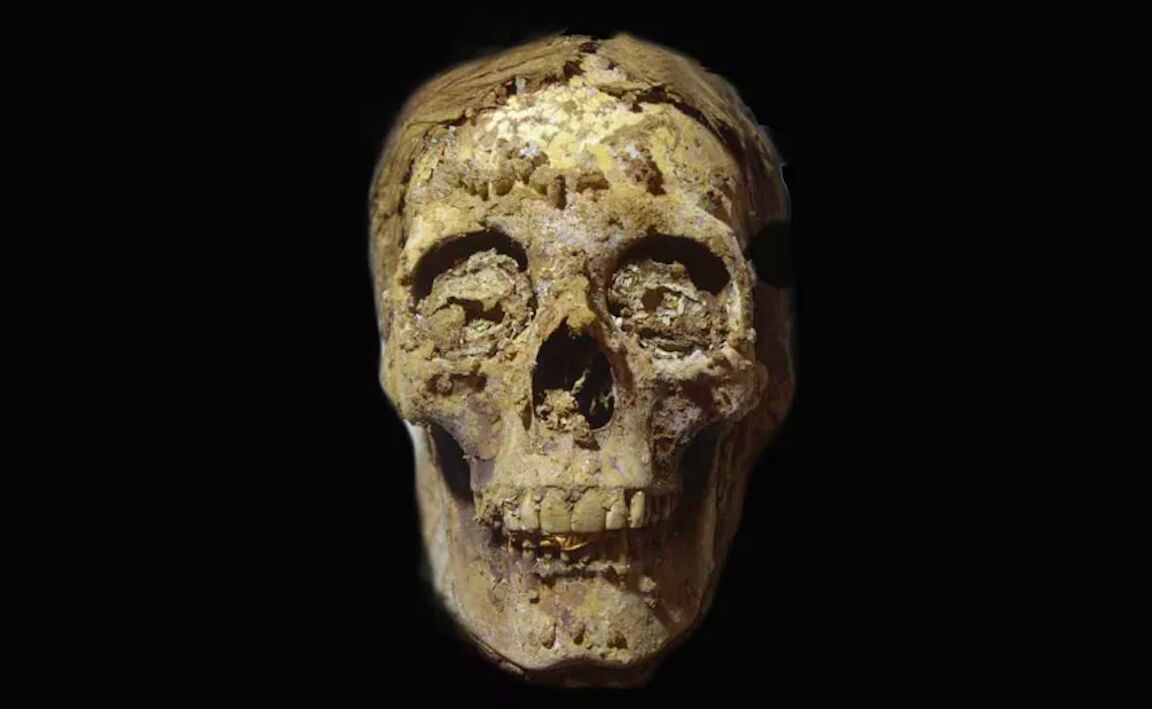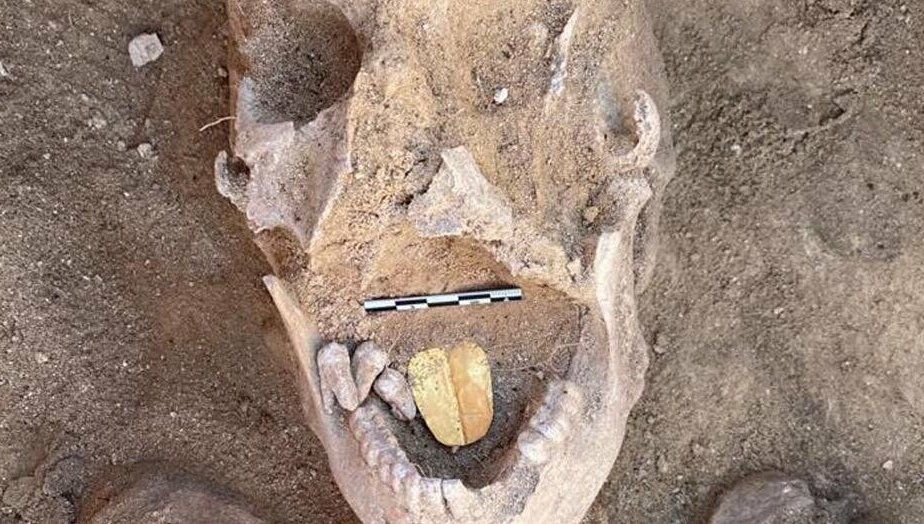In January of 2021, Egypt’s Ministry of Tourism and Antiquities announced a remarkable discovery at a site just outside Alexandria: Two 2,000-year-old mummies that, within their jaws, contained gold tongues. The peculiar find made headlines around the world. The discovery, together with a handful of other previously discovered gold tongues, relates to a time when Egypt was ruled by the Roman Empire.
Later that same year, Spanish archaeologists of the University of Barcelona, working in El Bahnasa, a Nile River town in central Egypt, made another remarkable parallel discovery: three burials (a man, woman and child), belonging to Egypt’s 26th Dynasty (seventh to sixth centuries b.c.e.), each containing a gold tongue. The woman’s and three-year-old child’s tomb had been raided in antiquity—clearly, the tongues overlooked—but the man’s tomb was in a pristine, untouched condition, an extremely rare and valuable find.

In their announcement of the discovery, Egypt’s Ministry of Tourism and Antiquities stated that the gold foil tongues were likely intended to help the dead speak with the gods in the afterlife. Commenting on the discovery, Dr. Lorelei Corcoran of the University of Memphis stated: “Within an Egyptian funerary context, its reference is to Spell 158 of the Book of the Dead [a text which first began to be composed c. 1550 b.c.e.], which ensures that the deceased has the ability to breathe and speak, as well as to eat and drink, in the afterlife. It may be conflated with the Greek funerary practice of placing a coin on or in the mouth of the deceased as payment for the ferryman, Caron, who transported the deceased across the River Styx to the Underworld.”
With these discoveries in mind, consider a peculiar biblical verse.

Several passages of the Hebrew Bible make figurative comparisons between the tongue and precious metals or jewels (i.e. Proverbs 10:20; 20:15; 25:11; Psalm 119:72). But an especially notable mention is found in Joshua 7.
The book of Joshua famously accounts the arrival of the Israelite slaves from Egypt into the Promised Land and the conquest of Canaan. Chapter 7 describes the first major setback for the Israelites—their defeat at Ai. Prior to this defeat, an individual named Achan had stolen certain items from the last-defeated city, Jericho, thus bringing a curse upon the Israelites.
In verses 20-21, Achan fesses up to his actions: “‘Of a truth I have sinned against the Lord, the God of Israel, and thus and thus have I done. When I saw among the spoil a goodly Shinar mantle [coat], and two hundred shekels of silver, and a wedge of gold of fifty shekels weight, then I coveted them, and took them; and, behold, they are hid in the earth in the midst of my tent, and the silver under it.’” The term “wedge” is not a literal translation; the Hebrew word is lashon, or “tongue.” Achan then is referring to a tongue of gold.
This Hebrew word for “tongue” is used 117 times in the Bible. In 111 cases, it is referring to either a literal tongue or speaking. Three times it is used to refer to a sea inlet, and once to refer to a flame of fire. The two other mentions are in Joshua 7, referring to this stolen piece of gold (verses 21, 24). Nowhere else is gold referred to in such a manner.

Some translators and commentators understandably take the reference as a figurative word for a wedge or bar of gold. Others, like the Jamieson, Fausset and Brown Commentary, take the reference to mean “literally, an ingot or bar in the shape of a tongue.” Gill’s Exposition of the Entire Bible calls it a “plate of gold in the shape of a tongue.”
The recent discoveries out of Egypt shine light on what appears to be a remarkable parallel. The Israelites, at this point in time, were an Egyptianized populace; many of the Torah laws that seem so peculiar today are actually a direct answer to pagan Egyptian customs. Perhaps in light of such Egyptian familiarity and practices, this gold object was referred to by Achan as a “tongue.” Or, perhaps in its most literal sense, it could have been just that: a burial tongue? At 50 shekels in weight, it would have been a far more substantive piece than the recently discovered gold tongues. Still (depending on the interpretation of weights during this period), this would have constituted an estimated total of 700 grams (25 ounces), perhaps less. In comparison, our modern Good Delivery standard gold brick (a familiar type often seen on TV or movies) weighs a whopping 12.4 kilograms (437 ounces, or 27.3 pounds)—more than 17 times the weight.

Canaan around this time (as the Amarna Letters show) was under heavy Egyptian influence and subservience. And it’s interesting also to note that this “tongue” was found along with an expensive wrap-around “mantle,” or cloak, as well as silver treasure. Perhaps they all belonged to the same setting—perhaps Achan could have raided someone’s literal tomb at Jericho—a “tongue” and coat/mantle going together as part of the burial.
For now, we can only speculate. But the parallel word-choice in Joshua 7 is fascinating—and it certainly wouldn’t be the first time the field of archaeology has not just confirmed biblical historicity, but illuminated biblical interpretation.

